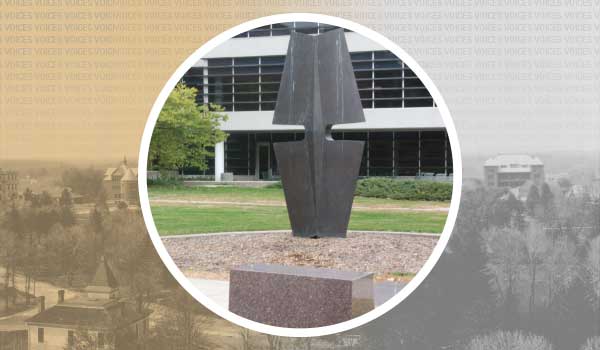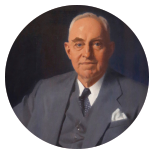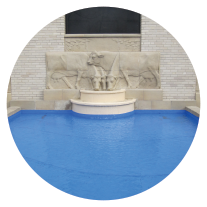
Art on Campus—Inspiring Learning, Agricultural Values
Iowa State University is proud to have the largest public art collection of any university in the nation. More than half of the 2,000 works in Iowa State’s Art on Campus Collection — murals, sculptures, drawings, paintings and more — represent agricultural themes. This is not by happy accident, but by purposeful planning.
This statement is grounded in a 19th century concept of inspired learning and agricultural values. The beauty of Iowa State was a practical, educational and aesthetic core value of the institution’s founders. That core value has continued nearly 160 years to ensure that beauty and aesthetics inspire learning while also being a transformative experience. Because this publication is all about stories, let me share a few brief stories of art and agriculture at Iowa State.
Two farmers, one vision.
Two farmers were responsible for conceiving the visual beauty of what was to become Iowa State College and Model Farm. Together, Peter Melendy and Adonijah Welch held many titles besides farmer, including board trustee, U.S. marshal, landscape designer, herdsman, politician, educator, orator, father and husband, college president and entrepreneur. Melendy first conceived of the central lawn of Iowa State. Upon Welch’s arrival as the founding president, he designed the central green with trees, lawns, shrubs and beautiful vistas. Together these two men established an aesthetic identify at Iowa State that continues today and has been cherished by hundreds of thousands.
Portraits of success.

Jay L. Lush by Joseph Allworthy (American, 1892-1991), 1956. Commissioned by Iowa State College. In the Art on Campus Collection, University Museums, Iowa State University. Located in Kildee Hall.
The animal science department was the first to routinely commission works of art to commemorate and celebrate distinguished faculty and alumni. These paintings established the Iowa State Portrait Collection, which was based on the famous portrait tradition of the Saddle and Sirloin Club in Chicago. By the early 1930s, Edward N. Wentworth (class of 1907 in animal science) chaired the Alumni Association Portrait Committee, resulting in many portraits of Iowa State’s presidents, division heads, distinguished faculty and alumni.
Iowa State Gothic.
Begun in 1934, Grant Wood’s When Tillage Begins mural illustrates the founding of Iowa agriculture in the 1840s; the founding and opening of Iowa State College in 1860s and 1870s; and, the condition of higher education and agriculture in 1930s. Wood depicted Abraham Lincoln farming the land in youth, middle age and maturity — the visual subtext being: “Work hard (in agriculture), get an education (at Iowa State) and you, too, can grow up to be president and sign the Morrill Act that secured an education for millions of people.”
An historic first.

History of Dairying, 1934 by Christian Petersen (Danish-American, 1885-1961). Commissioned by Iowa State College for the Dairy Industry Building. In the Christian Petersen Art Collection, Art on Campus Collection, University Museums, Iowa State University. Located in the Food Sciences Building.
The History of Dairying bas relief mural is believed to be the first site-specific, federal Public Works of Art Project (popularly known as WPA) sculpture project in the United States. The sculpture, located in the Food Sciences Building courtyard, was undertaken by Christian Petersen within the first weeks of the law passing in late 1933. With the commissioning of this mural, Petersen became the nation’s first, permanent campus sculptor-in-residence. He created 12 public works of art from 1934 to 1955, most of which referenced agricultural themes, including many of Iowa State’s most iconic, including The History of Dairying (1934-35), Fountain of the Four Seasons (1941), the Veterinary Medicine Mural (1936-37) and The Gentle Doctor (1937).
Soil and civilizations.
Janus Agri Altar (1984-1986) in the Agronomy Hall courtyard was sculpted in bronze by internationally acclaimed artist Beverly Pepper in her Todi, Italy, studio. Agronomy faculty tutored Pepper in the role of agriculture in world development. Janus Agri Altar depicts an ancient digging adze portrayed in heroic scale, and symbolizes when humanity works the soil with seed and relies upon weather cycles, agriculture establishes civilizations.
The Dean’s Gallery.
Opening in 2013, the College of Agriculture and Life Sciences Dean’s Art Gallery in Curtiss Hall is the first of its kind at Iowa State. Selections from the permanent collections create exhibitions exploring aesthetics and agriculture. Currently the exhibition focuses on round hay bales. Patented by Wesley Buchele, professor of agricultural engineering from 1963 to 1989, the round baler is a farm innovation with a profound visual impact of popularly characterizing Midwestern agricultural landscapes — similar to the 19th century painted hay stacks by French Impressionist Claude Monet.
Want to know more stories about why and how Iowa State is one of the most beautiful campuses in the United States? Campus Beautiful: Shaping the Aesthetic Identity of Iowa State University is a scholarship book that explores the landscape, architecture and public art developments at Iowa State University over its 160 years. Researched and published by the University Museums, the 450-page book with over 400 photographs will be available September 2015.


